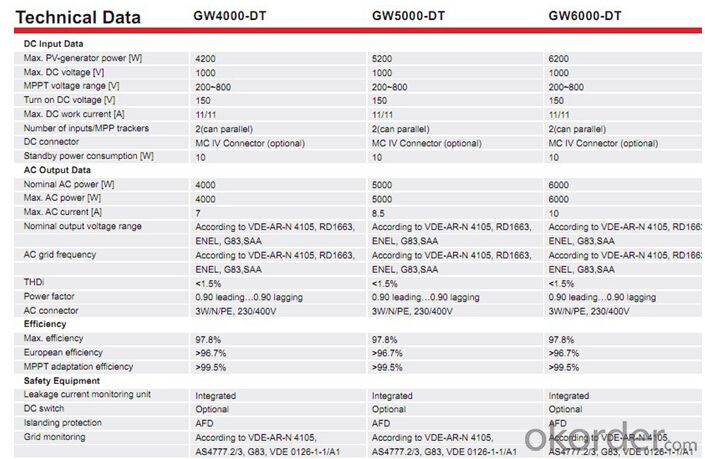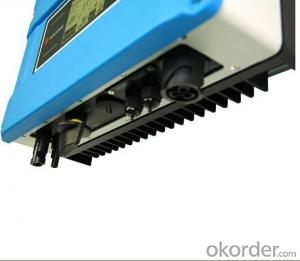On grid solar inverter GW6000-DT
OKorder Service Pledge
Quality Product, Order Online Tracking, Timely Delivery
OKorder Financial Service
Credit Rating, Credit Services, Credit Purchasing
You Might Also Like
GW6000-DT inverters are typically designed for home solar systems,
4kW/5kW/6kW.By adopting cutting-edge technology of photovoltaic field,
it provides three making home system connection well balanced ,safer and more convenient.
The integrated allow two-array inputs from different roof orientations.
And the combination of both RS485 communication makes the system well interactive and extremely easy to be monitored.
Datasheet

- Q:What is the maximum AC output current that a solar inverter can provide?
- The maximum AC output current that a solar inverter can provide depends on the specific model and capacity of the inverter. In general, it is determined by factors such as the maximum power rating and efficiency of the inverter, as well as the size and configuration of the solar photovoltaic (PV) system it is connected to.
- Q:Are there any limitations on the angle of the solar panels when using a solar inverter?
- Yes, there are limitations on the angle of the solar panels when using a solar inverter. The optimal angle for solar panels is typically determined based on the geographical location and the season. Deviating too much from the recommended angle can result in decreased energy production.
- Q:Can a solar inverter be used with solar-powered electric fences?
- Yes, a solar inverter can be used with solar-powered electric fences. Solar inverters are used to convert the direct current (DC) produced by solar panels into alternating current (AC) that can be used to power various electrical devices, including electric fences. By connecting a solar inverter to the solar panels of a solar-powered electric fence system, the DC power generated by the panels can be converted into the AC power required to operate the electric fence.
- Q:Can a solar inverter be used with a solar-powered vehicle?
- Yes, a solar inverter can be used with a solar-powered vehicle. A solar inverter is responsible for converting the direct current (DC) produced by solar panels into alternating current (AC) that can be used to power various devices. In a solar-powered vehicle, the solar panels generate DC electricity, which can be connected to a solar inverter to convert it into AC power that can be used to charge the vehicle's battery or directly power electric components.
- Q:Can a solar inverter be used in a hybrid solar system?
- Yes, a solar inverter can be used in a hybrid solar system. A hybrid solar system combines solar power with other sources of energy, such as batteries or a backup generator. The solar inverter is responsible for converting the DC electricity generated by the solar panels into AC electricity that can be used to power appliances and other electrical devices. In a hybrid system, the solar inverter works in conjunction with other components, such as a battery inverter or a grid tie inverter, to manage the flow of electricity between the solar panels, batteries, and the electrical grid.
- Q:Can a solar inverter convert DC power to AC power?
- Yes, a solar inverter can convert DC power generated by solar panels into AC power suitable for household or grid use.
- Q:Can a solar inverter be used with a solar-powered desalination system?
- Yes, a solar inverter can be used with a solar-powered desalination system. A solar inverter is needed to convert the direct current (DC) produced by solar panels into alternating current (AC) that can be used to power the desalination system. This allows for the efficient utilization of solar energy in powering the desalination process.
- Q:Can a solar inverter be used with different types of solar cell technologies?
- Yes, a solar inverter can be used with different types of solar cell technologies. Solar inverters are designed to convert the direct current (DC) produced by solar cells into alternating current (AC) that can be used to power homes and businesses. They are typically compatible with various solar cell technologies, such as monocrystalline, polycrystalline, thin-film, and hybrid solar cells. This versatility allows the solar inverter to work efficiently with different types of solar panels, maximizing the energy production from the solar system.
- Q:Are there any safety risks associated with solar inverters?
- Yes, there are potential safety risks associated with solar inverters. These risks can include electrical hazards, such as electric shock or fire, especially if the inverter is not installed or maintained correctly. Additionally, there is a possibility of arc flash incidents and potential exposure to high voltage DC electricity. It is important to follow proper installation and maintenance procedures, as well as adhere to safety guidelines provided by manufacturers and professionals, to mitigate these risks and ensure safe operation of solar inverters.
- Q:What is the role of a fault detection feature in a solar inverter?
- The solar inverter relies on a fault detection feature to oversee and detect any irregularities or malfunctions within the system. This crucial feature is essential for the smooth and efficient functioning of the solar inverter. Constantly monitoring the solar inverter's various components and parameters, such as input and output voltages, current levels, temperature, and other critical factors, the fault detection feature analyzes real-time data and compares it to predetermined thresholds or expected values. If any parameter strays from the normal range or exceeds set limits, the fault detection feature promptly identifies it as a fault or abnormality. The primary objective of this feature is to safeguard the solar inverter from potential harm and prevent any safety risks. By swiftly detecting faults, the inverter can take appropriate actions to address the issue or shut down the system if necessary. This safeguards the inverter and other connected devices from further damage. Additionally, the fault detection feature aids in troubleshooting and determining the root cause of the fault. It offers valuable information about the fault's type and location, enabling faster and more accurate repairs or maintenance. This reduces downtime and ensures optimal performance and longevity of the solar inverter. Furthermore, the fault detection feature plays a vital role in system monitoring and maintenance. It provides valuable data and notifications to system operators or maintenance personnel, allowing them to proactively address any potential issues. This maximizes the uptime of the solar inverter and minimizes overall maintenance costs. To summarize, the fault detection feature in a solar inverter continuously monitors, identifies, and responds to faults or abnormalities in the system. Acting as a protective mechanism, it ensures the safe and reliable operation of the inverter, enables swift troubleshooting, and facilitates efficient maintenance practices.
1. Manufacturer Overview |
|
|---|---|
| Location | |
| Year Established | |
| Annual Output Value | |
| Main Markets | |
| Company Certifications | |
2. Manufacturer Certificates |
|
|---|---|
| a) Certification Name | |
| Range | |
| Reference | |
| Validity Period | |
3. Manufacturer Capability |
|
|---|---|
| a)Trade Capacity | |
| Nearest Port | |
| Export Percentage | |
| No.of Employees in Trade Department | |
| Language Spoken: | |
| b)Factory Information | |
| Factory Size: | |
| No. of Production Lines | |
| Contract Manufacturing | |
| Product Price Range | |
Send your message to us
On grid solar inverter GW6000-DT
OKorder Service Pledge
Quality Product, Order Online Tracking, Timely Delivery
OKorder Financial Service
Credit Rating, Credit Services, Credit Purchasing
Similar products
New products
Hot products
Hot Searches
Related keywords































